Graphite Compactness Degree and Nodularity of High-Si Ductile Iron Produced via Permanent Mold versus Sand Mold Casting
Abstract
:1. Introduction
2. Background
3. Materials and Methods
4. Results
4.1. Structure Characteristics
4.2. Graphite Size and Count Characteristics
4.3. Graphite Particles Shape Factors
4.4. Graphite Nodularity
5. Conclusions
- (1)
- A higher solidification cooling rate in the metal mold led to a higher graphite particle count compared to the sand mold, with the difference increasing as the wall thickness increased, but the metal mold casting was less dependent on the increase in the section size.
- (2)
- The metal mold casting was characterized by the finest graphite nodules, mainly less than 15 µm in size (the rest of 15–30 µm size), which were at the same level as the total number of graphite particles in the sand mold casting (with a prevalent 15–30 µm size).
- (3)
- The graphite particles’ real perimeter was 3–5% higher than the convex perimeter, while the values of these parameters were 41–43% higher in the sand mold. The increase in the casting section size favored the increase in graphite perimeter, with it being much more for the sand mold. The difference between the graphite particles’ perimeter in the sand mold and metal mold for a given casting section size was higher for Pr than for Pc.
- (4)
- The graphite particles’ shape factors, involving the maximum and minimum size, were at a lower level for the metal mold solidification (1.2–1.3) compared to the sand mold casting (1.3–1.5), which expressed a higher compactness degree and had a lower dependence on the casting wall thickness.
- (5)
- The convexity shape factor, which involves the difference between the real and convex perimeter of graphite particles and reaching 1.0 when Pr = Pc, was higher for the metal mold (0.93–0.94 versus 0.91–0.92); there was a low dependence on the wall thickness variation and a good relationship between obtained data for these parameters.
- (6)
- For the shape factor involving graphite particles area and the maximum size, the metal mold solidification had a higher graphite compactness degree, as this factor had higher values than in the sand mold casting: RSF = 0.68–0.7 versus 0.59–0.64. The wall thickness variation had a small effect on the sand mold, but practically no effect on the metal mold.
- (7)
- The graphite nodularity level depended on the mold’s thermal properties: the solidification in the metal mold, with its higher cooling rate, led to a higher level of nodularity.
- (8)
- The higher the considered graphite compactness degree level (shape factor increasing from 0.50 up to 0.80), the lower the resulting graphite nodularity for both the metal mold (39.1% versus 88.5%) and sand mold (32.3% versus 83.1%). It also increased the difference between the metal mold and sand mold regarding the average graphite nodularity in favor of the metal mold.
Author Contributions
Funding
Institutional Review Board Statement
Informed Consent Statement
Data Availability Statement
Conflicts of Interest
Abbreviations
| PMT | Photomultiplier tubes |
| CCD | Spectroscopic charge-coupled device |
| DI | Ductile iron |
| CE | Carbon equivalent |
| Pc | Convex perimeter |
| Pr | Real perimeter |
| AG | Graphite area |
| DMin/Mean/Max | Minimum/mean/maximum diameter |
| FMin/Mean/Max | Minimum/mean/maximum Ferret |
| AR | Aspect ratio |
| E | Elongation |
| Cv | Convexity |
| WT | Wall thickness |
| SM | Sand mold |
| MM | Metal mold |
| RSF | Roundness shape factor |
| NG1 | Graphite nodularity calculated with Equation (3) |
| NG2 | Graphite nodularity calculated with Equation (4) |
| Atot | Area of all graphite particles |
| Aparticle(RSF) | Area of graphite particle at a minimum imposed RSF |
References
- Lacaze, J.; Dawson, S.; Hazotte, A. Cast Iron: A Historical and Green Material Worthy of Continuous Research. Int. J. Technol. 2021, 12, 1123–1138. [Google Scholar] [CrossRef]
- Riposan, I.; Chisamera, M.; Stan, S.; Grasmo, G.; Hartung, C.; White, D. Iron Quality Control during Melting in Coreless Induction Furnace. AFS Trans. 2009, 117, 423. [Google Scholar]
- Riposan, I.; Chisamera, M.; Stan, S.; White, D. Complex (Mn, X) S compounds-major sites for graphite nucleation in grey cast iron. China Foundry 2009, 6, 352–358. [Google Scholar]
- Cast Iron. Available online: https://en.wikipedia.org/wiki/Ductile_iron (accessed on 30 December 2021).
- ISO 1083. Spheroidal Graphite Cast Irons—Classification. 2018. Available online: https://www.iso.org/standard/66643.html (accessed on 13 April 2021).
- Stan, S.; Riposan, I.; Chisamera, M.; Barstow, M. Solidification Pattern of Silicon Alloyed Ductile Cast Irons. In Proceedings of the 122nd AFS Metalcasting Congress, Fort Worth, TX, USA, 3–5 April 2018; pp. 18–22. [Google Scholar]
- Riposan, I.; Chisamera, M.; Stan, S. Control of surface graphite degeneration in ductile iron for windmill applications. Int. J. Met. 2013, 7, 9–20. [Google Scholar] [CrossRef]
- Alhussein, A.; Risbet, M.; Bastien, A.; Chobaut, J.P.; Balloy, D.; Favergeon, J. Influence of silicon and addition elements on the mechanical behavior of ferritic ductile cast iron. Mater. Sci. Eng. A 2014, 605, 222–228. [Google Scholar] [CrossRef]
- Franzen, D.; Weiß, P.; Pustal, B.; Buhrig-Polaczek, A. Modification of silicon microsegregation in solid solution strengthened ductile iron by alloying with aluminum. Int. J. Met. 2020, 14, 1105–1114. [Google Scholar] [CrossRef] [Green Version]
- Soivio, K. Austempering experiments of production grade silicon solution strengthened ductile iron. Mater. Sci. Forum 2018, 925, 239–245. [Google Scholar] [CrossRef] [Green Version]
- Gebhardt, C.; Nellessen, J.; Bührig-Polaczek, A.; Broeckmann, C. Influence of Aluminum on Fatigue Strength of Solution-Strengthened Nodular Cast Iron. Metals 2021, 11, 311. [Google Scholar] [CrossRef]
- Bauer, B.; Mihalic Pokopec, I.; Petric, M.; Mrvar, P. Effect of Si and Ni addition on graphite morphology in heavy section spheroidal graphite iron parts. Mater. Sci. Forum 2018, 925, 70–77. [Google Scholar] [CrossRef] [Green Version]
- Larranaga, P.; Asenjo, I.; Sertucha, J.; Suarez, R.; Ferrer, I.; Lacaze, J. Effect of antimony and cerium on the formation of chunky graphite during solidification of heavy-section castings of near-eutectic spheroidal graphite irons. Metall. Mater. Trans. A 2009, 40, 654–661. [Google Scholar] [CrossRef] [Green Version]
- Stets, W.; Loblich, H.; Gassner, G.; Schumacher, P. Solution Strengthened Ferritic Ductile Cast Iron According DIN EN1563:2012—Properties, Production and Application. In Proceedings of the “Keith Millis” Symposium on Ductile Iron, Nashville, TN, USA, 15–17 October 2013; pp. 283–292. [Google Scholar]
- Dommaaschk, C. Chances and Limits of High Silicon Ductile Iron. In Proceedings of the WFO Technical Forum, Gauteng, South Africa, 14–17 March 2017. [Google Scholar]
- Sertucha, J.; Artola, G.; De La Torre, U.; Lacaze, J. Chunky Graphite in Low and High Silicon Spheroidal Graphite Cast Irons–Occurrence, Control and Effect on Mechanical Properties. Materials 2020, 13, 5402. [Google Scholar] [CrossRef]
- Stan, S.C.; Chisamera, M.; Riposan, I.; Neacsu, E.L.; Cojocaru, A.M. Structure characteristics of silicon alloyed ductile cast iron. IOP Conf. Ser. Mater. Sci. Eng. 2018, 416, 012077. [Google Scholar] [CrossRef]
- Stan, S.; Riposan, I.; Chisamera, M.; Stan, I. Solidification characteristics of silicon alloyed ductile cast irons. J. Mater. Eng. Perform. 2019, 28, 278–286. [Google Scholar] [CrossRef]
- Riposan, I.; Stefan, E.; Stan, S.; Pana, N.R.; Chisamera, M. Effects of Inoculation on Structure Characteristics of High Silicon Ductile Cast Irons in Thin Wall Castings. Metals 2020, 10, 1091. [Google Scholar] [CrossRef]
- Borsato, T.; Ferro, P.; Berto, F.; Carollo, C. Effect of Solidification Time on Microstructural, Mechanical and Fatigue Properties of Solution Strengthened Ferritic Ductile Iron. Metals 2019, 9, 24. [Google Scholar] [CrossRef] [Green Version]
- Górny, M.; Kawalec, M.; Gracz, B.; Tupaj, M. Influence of Cooling Rate on Microstructure Formation of Si–Mo Ductile Iron Castings. Metals 2021, 11, 1634. [Google Scholar] [CrossRef]
- Alonso, G.; Stefanescu, D.M.; Bravo, B.; Zarrabeitia, G.; Suarez, R. Nodule Count, End of Solidification Cooling Rate, and Shrinkage Porosity Correlations in High Silicon Spheroidal Graphite Iron. Minerals 2021, 11, 155. [Google Scholar] [CrossRef]
- Riebisch, M.; Seiler, C.; Pustal, B.; Buhrig-Polaczek, A. Microstructure of As-Cast High-Silicon Ductile Iron Produced via Permanent Mold Casting. Int. J. Met. 2019, 13, 112–120. [Google Scholar] [CrossRef]
- Riposan, I.; Stan, S.; Anca, D.; Stefan, E.; Stan, I.; Chisamera, M. Structure Characteristics of High-Si Ductile Cast Irons. In Proceedings of the 74th World Foundry Congress, Busan, Korea, 16–20 October 2022. [Google Scholar]
- Hammersberg, P.; Hamberg, K.; Bjorkegren, L.E.; Lindkvist, J.; Borgstrom, H. Sensitivity to Variation of Tensile Properties of High Silicon Ductile Iron. Mater. Sci. Forum 2018, 925, 280–287. [Google Scholar] [CrossRef] [Green Version]
- Lacaze, J.; Sertucha, J.; Larranaga, P.; Suarez, R. Effect of carbon, silicon, nickel and other alloying elements on the mechanical properties of as-cast ferritic ductile irons. In Proceedings of the 71st World Foundry Congress, Bilbao, Spain, 19–21 May 2014. [Google Scholar]
- Riposan, I.; Chisamera, M.; Stan, S.; White, D. Chilling properties of Ba/Ca/Sr inoculated grey cast irons. Int. J. Cast Met. Res. 2007, 20, 90–97. [Google Scholar] [CrossRef]
- Riebisch, M.; Pustal, B.; Bührig-Polaczek, A. Impact of carbide-promoting elements on the mechanical properties of solid-solution-strengthened ductile iron. Int. J. Met. 2020, 14, 365–374. [Google Scholar] [CrossRef]
- ISO 16112. Compacted (Vermicular) Graphite Cast Irons–Classification. 2017. Available online: https://www.iso.org/standard/67755.html (accessed on 8 November 2021).
- ISO 945-4-2019; Microstructure of Cast Irons-Part 4: Determination of Nodularity in Spheroidal Graphite Cast Irons. International Standard Organization (ISO): Geneva, Switzerland, 2019.
- GB/T 9441-2009; Metallographic Test for Evaluation of Spheroidal Graphite Cast Iron. Standardization Administration of China: Beijing, China, 2009.
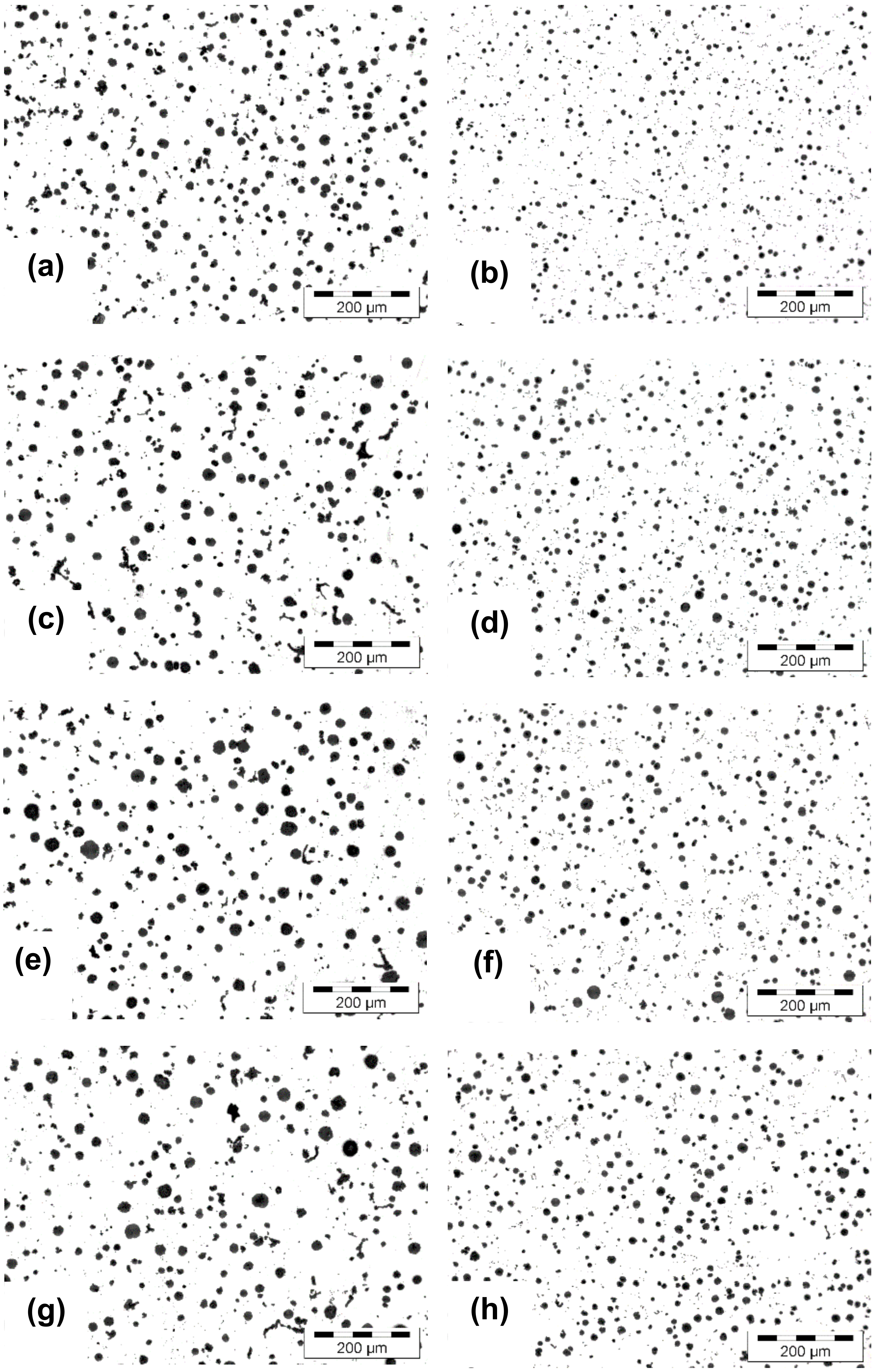

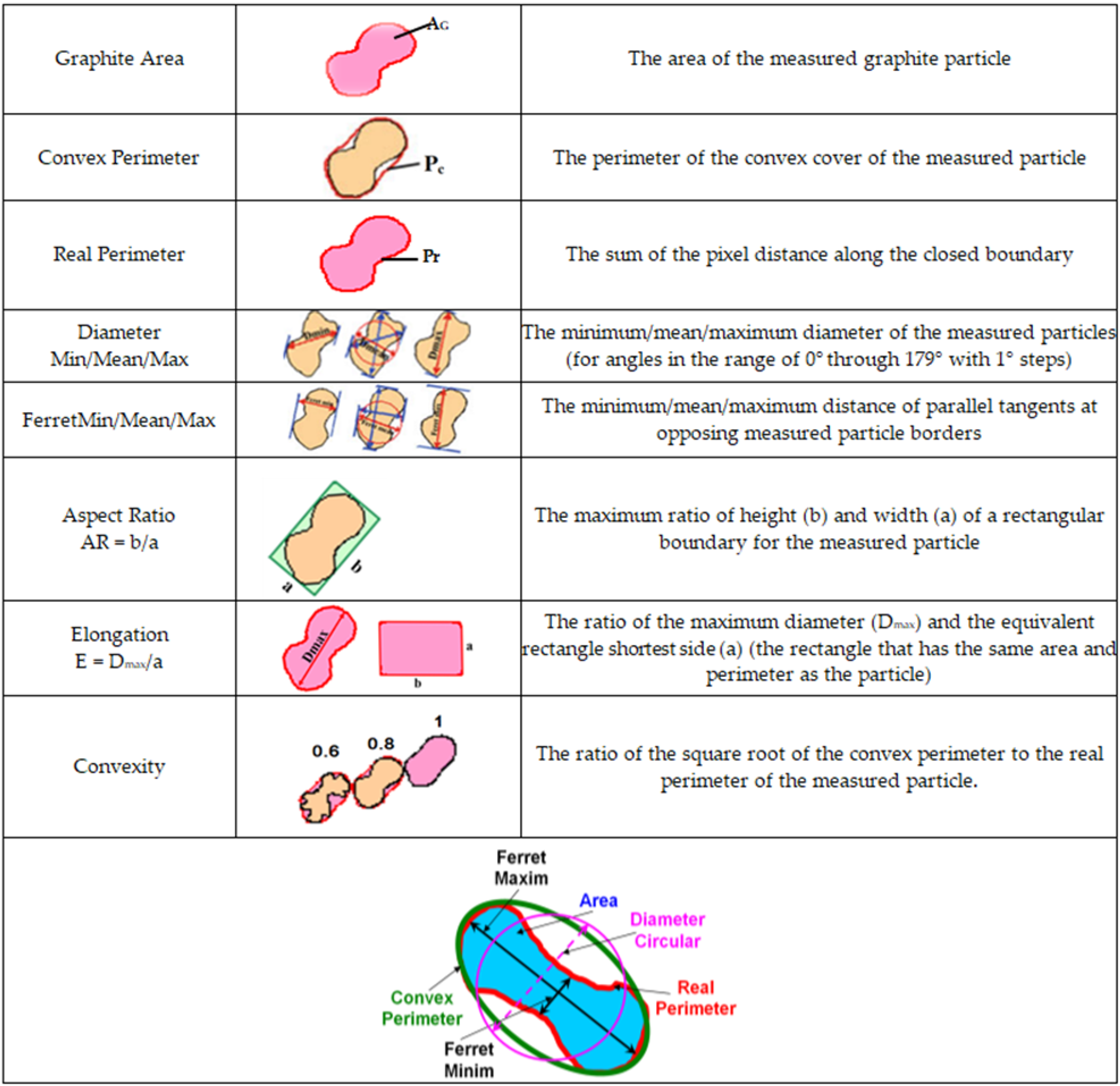
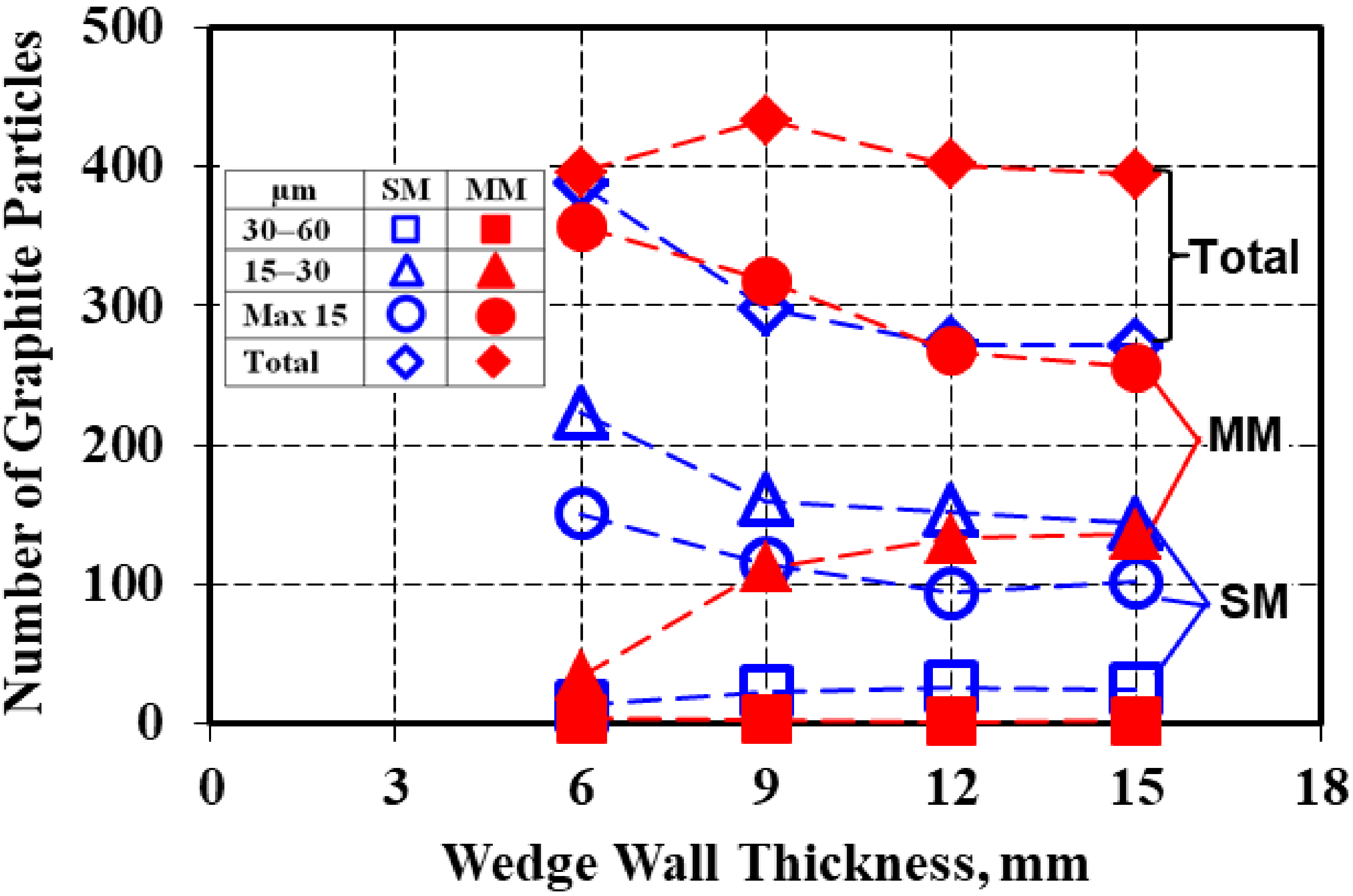
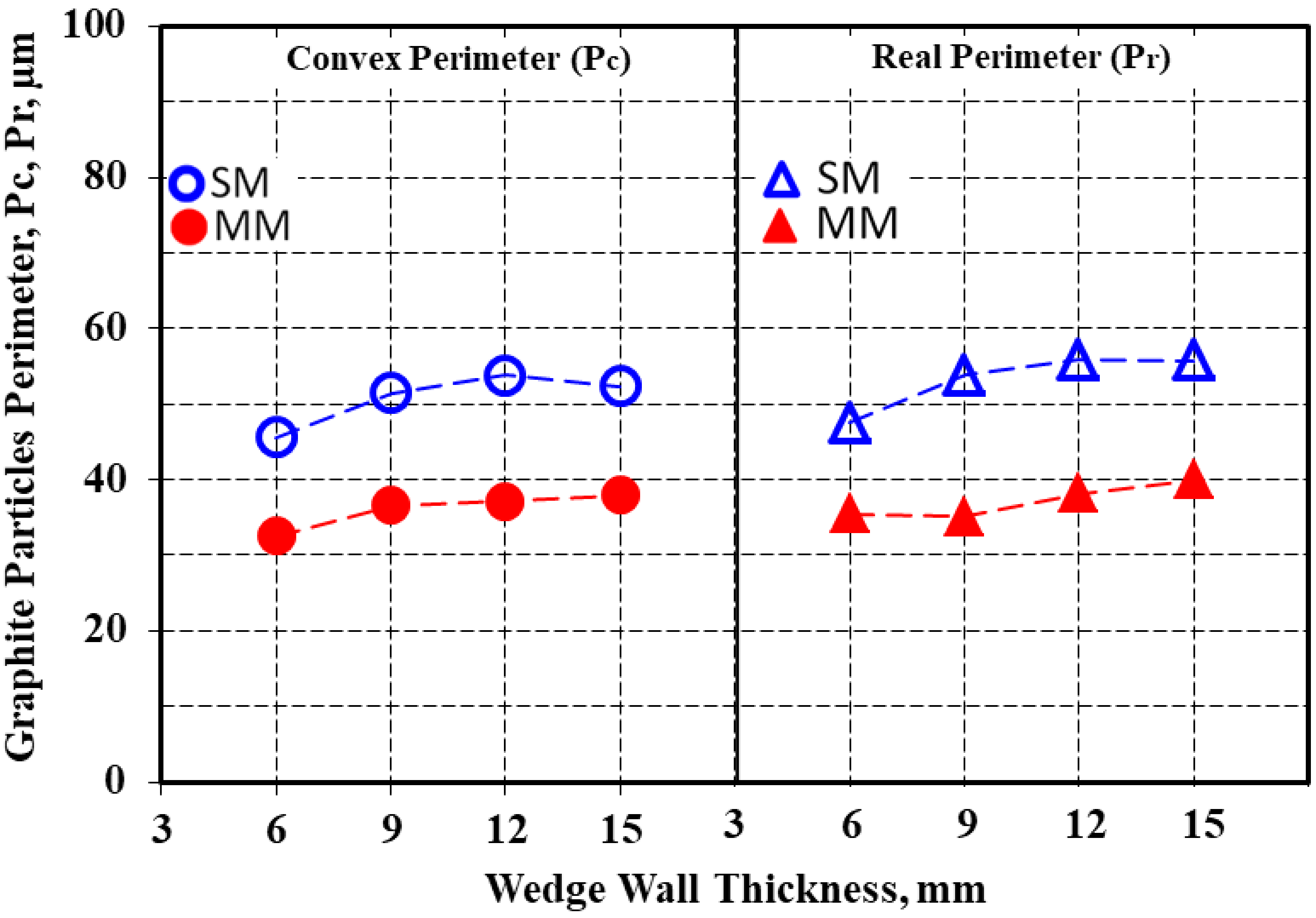

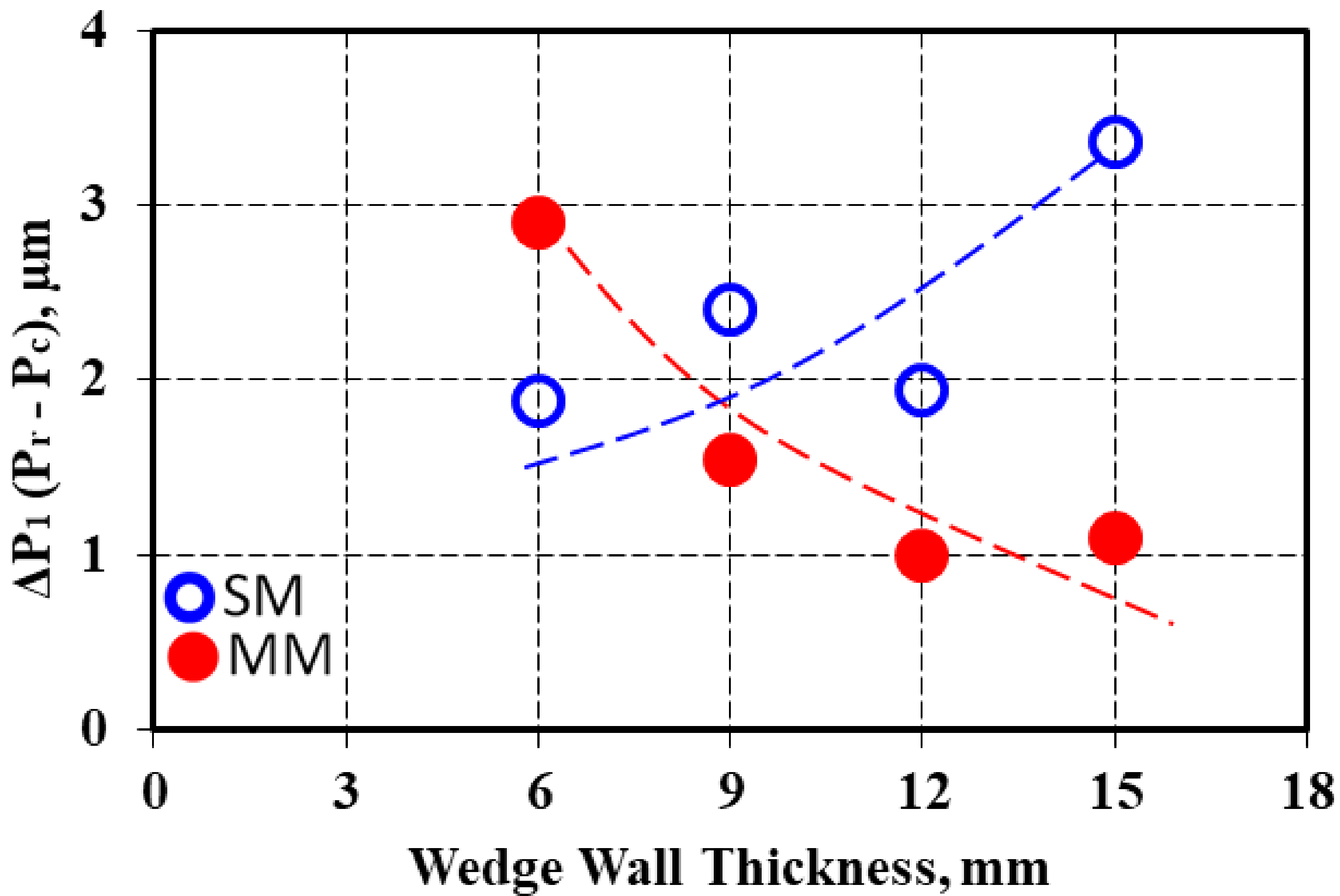
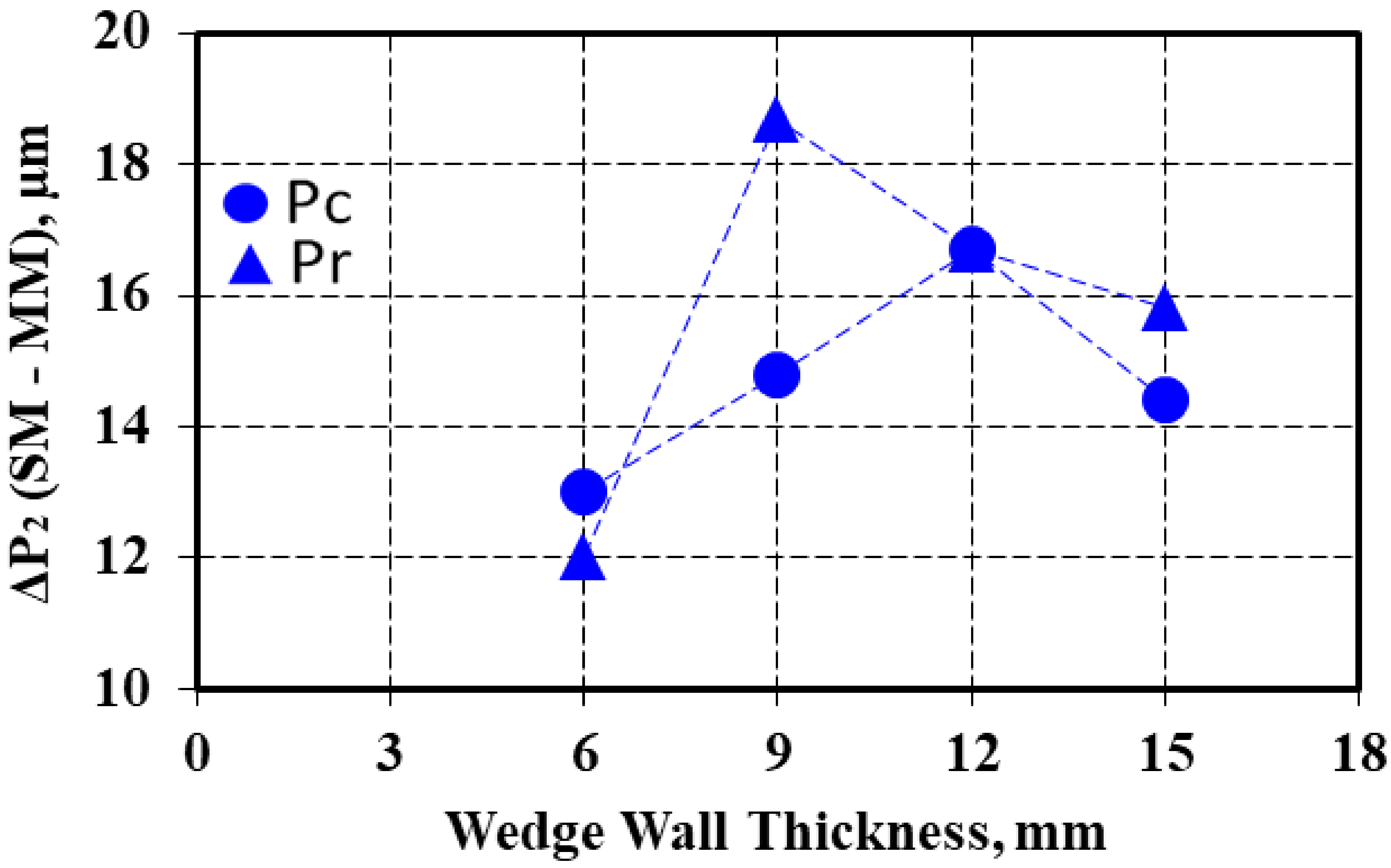
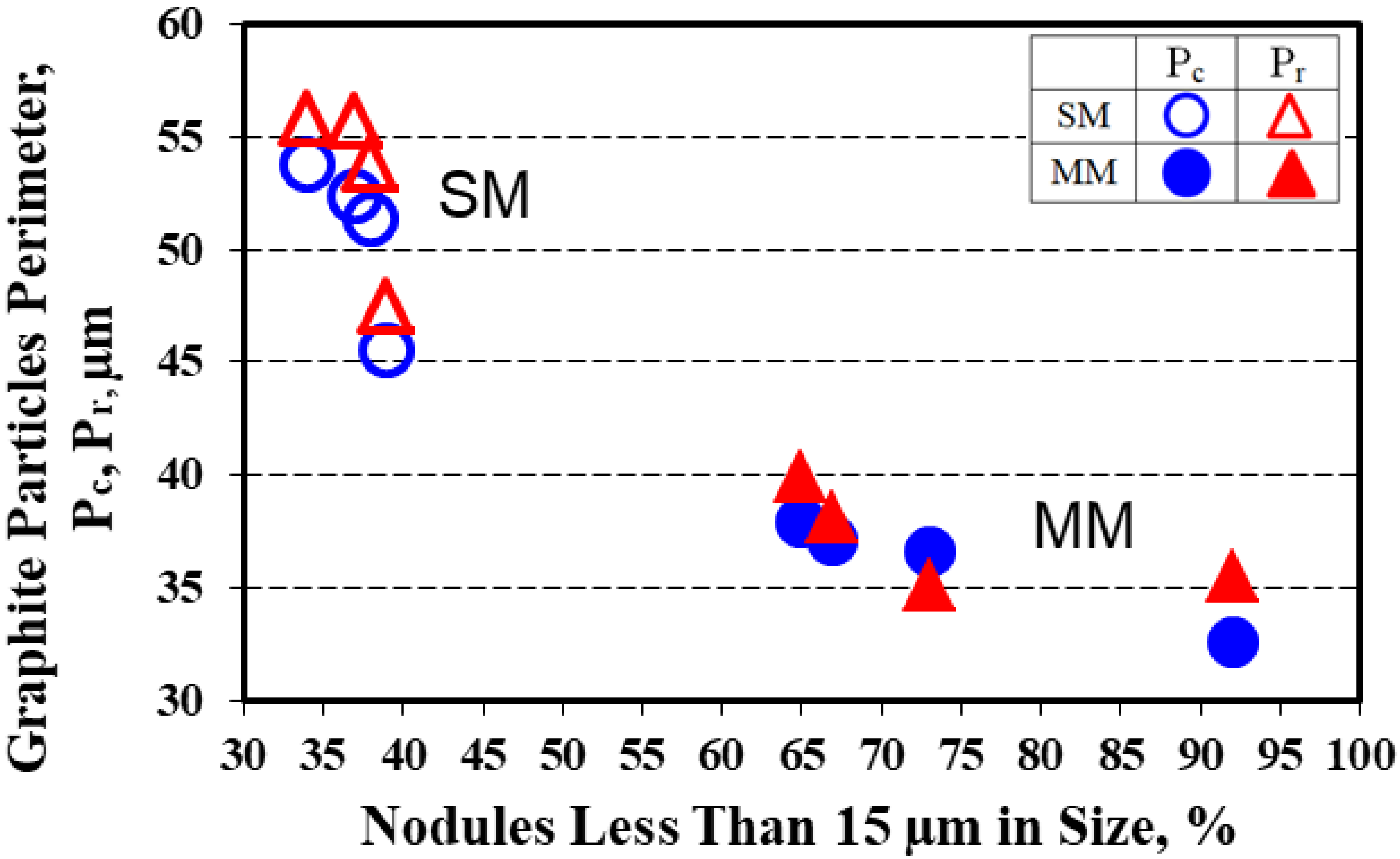
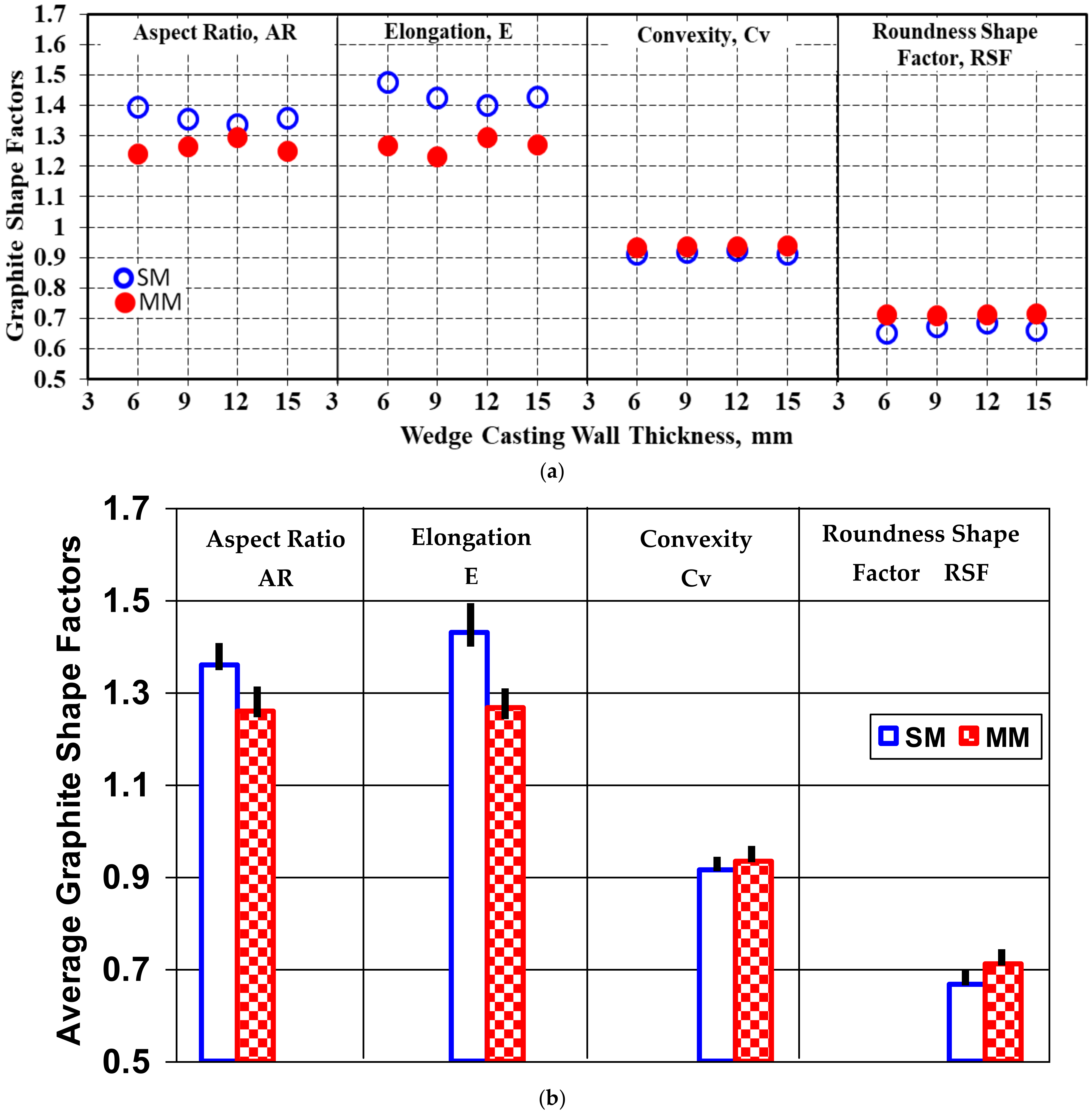
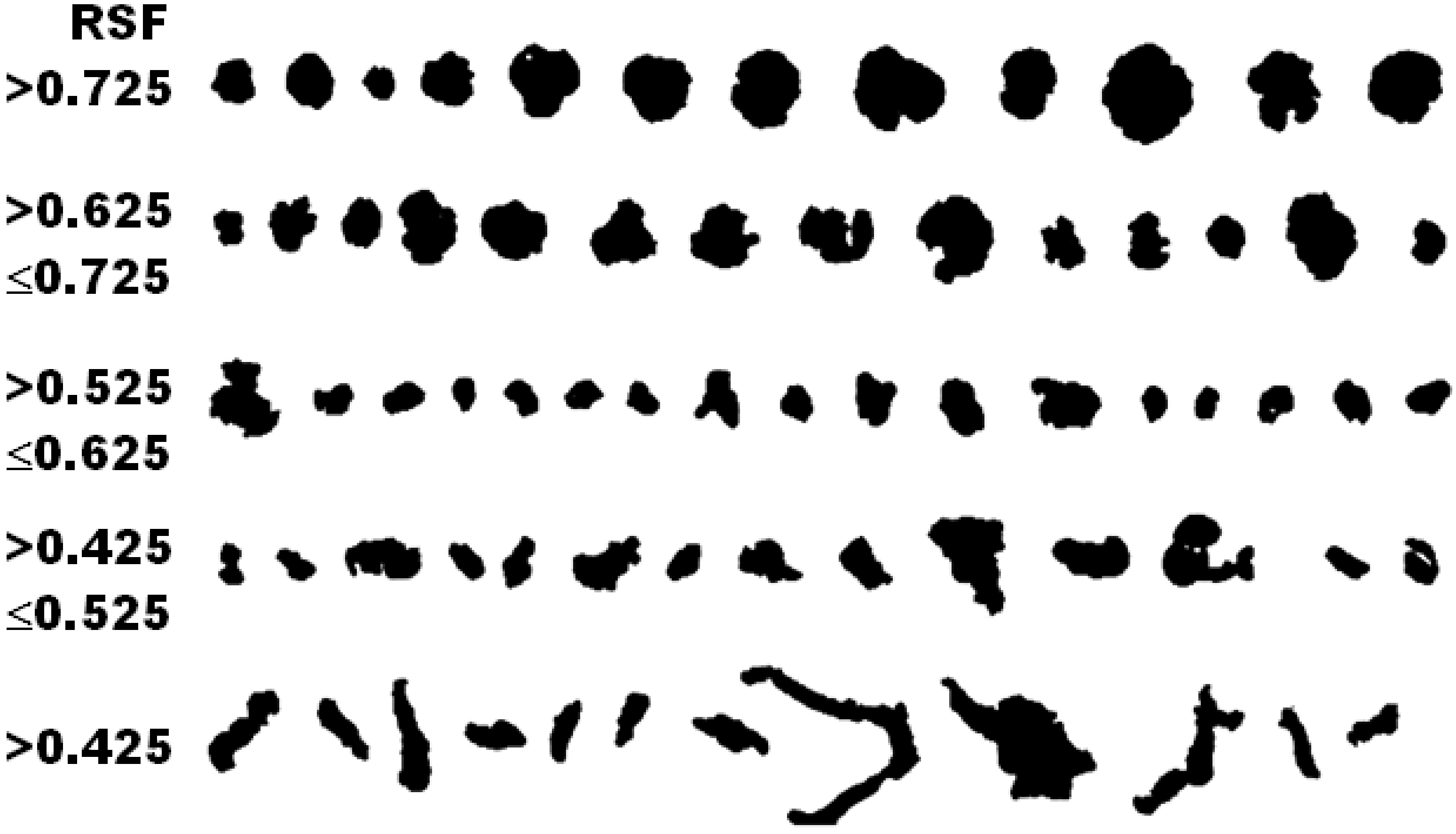
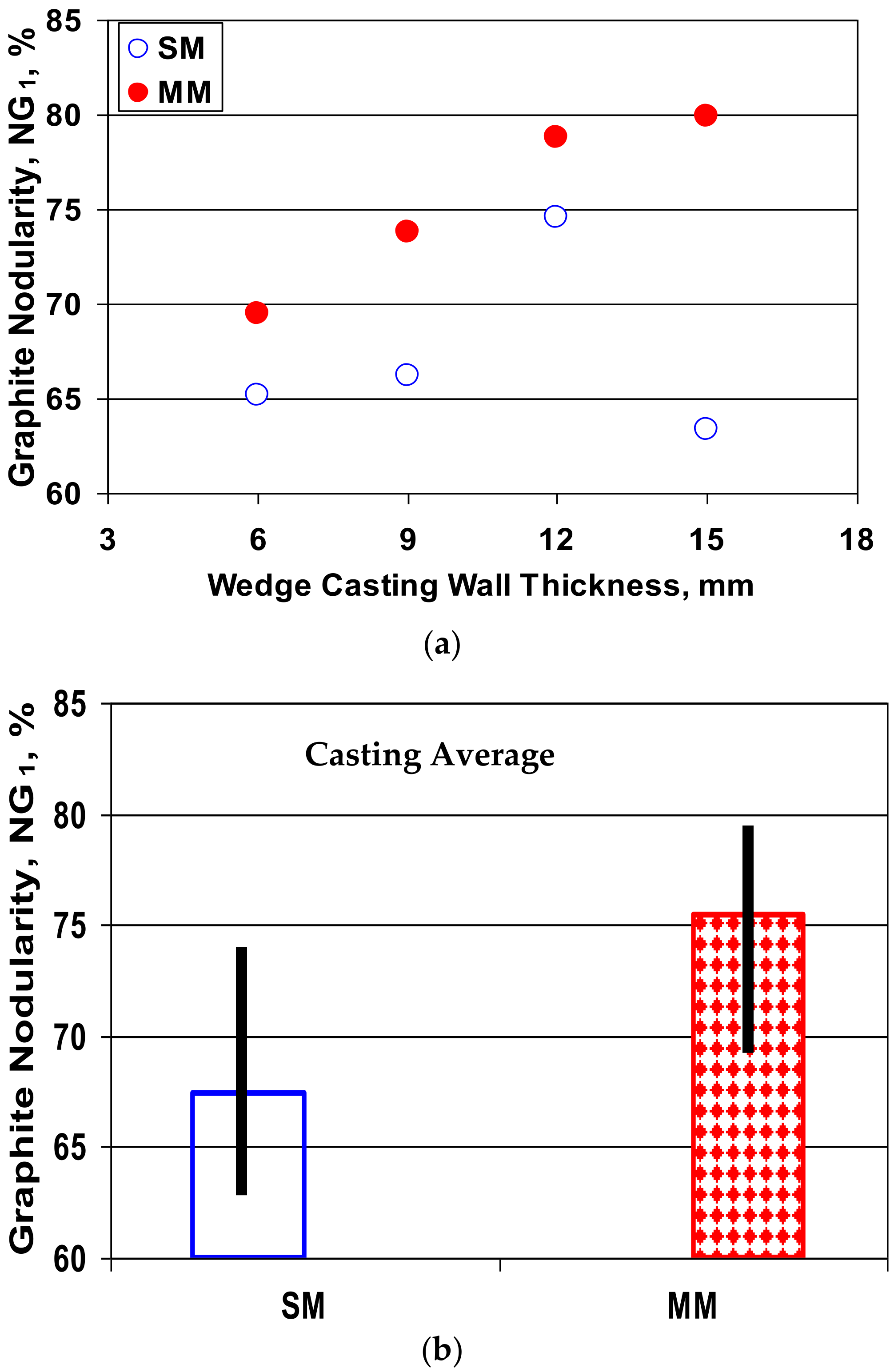
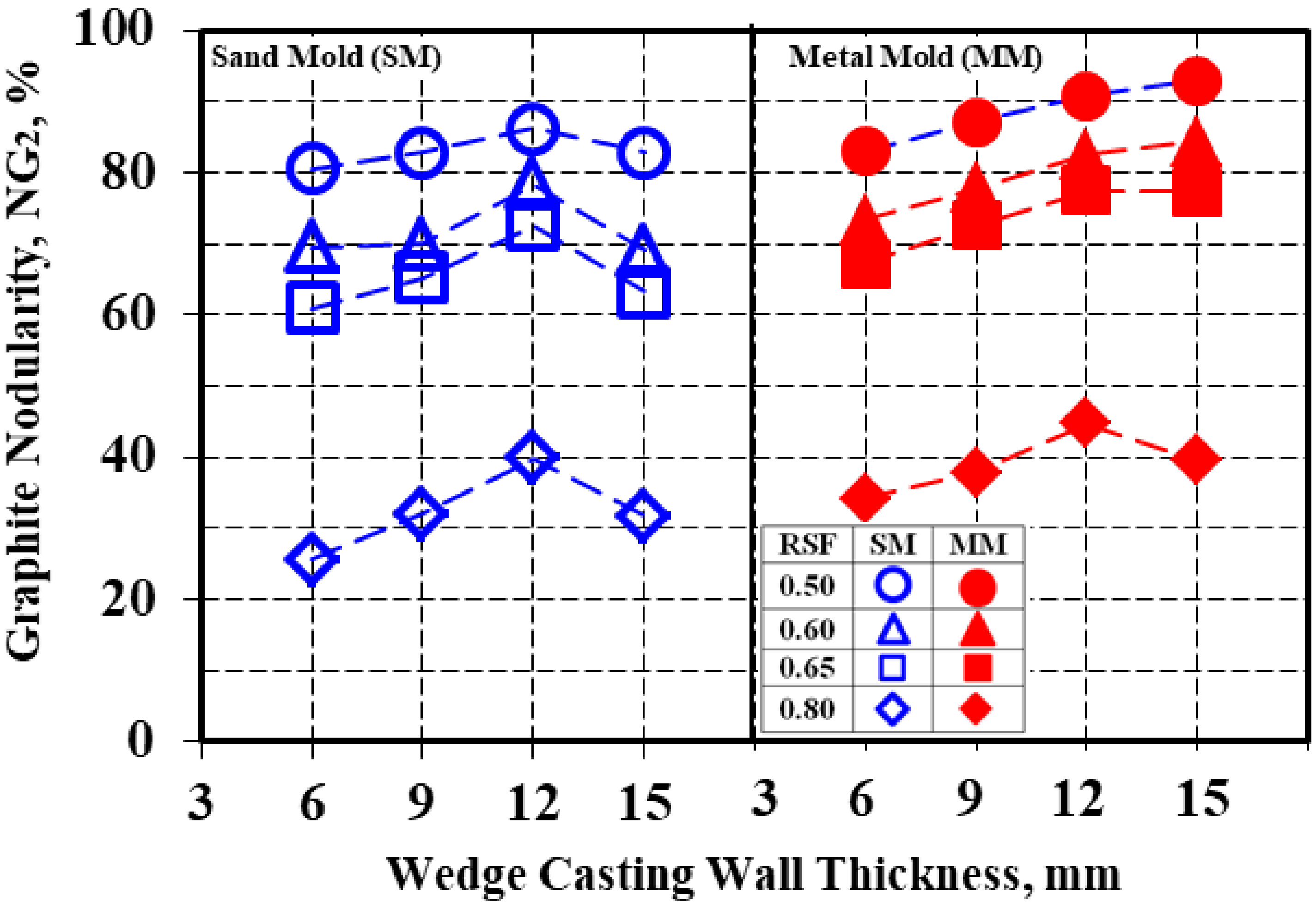

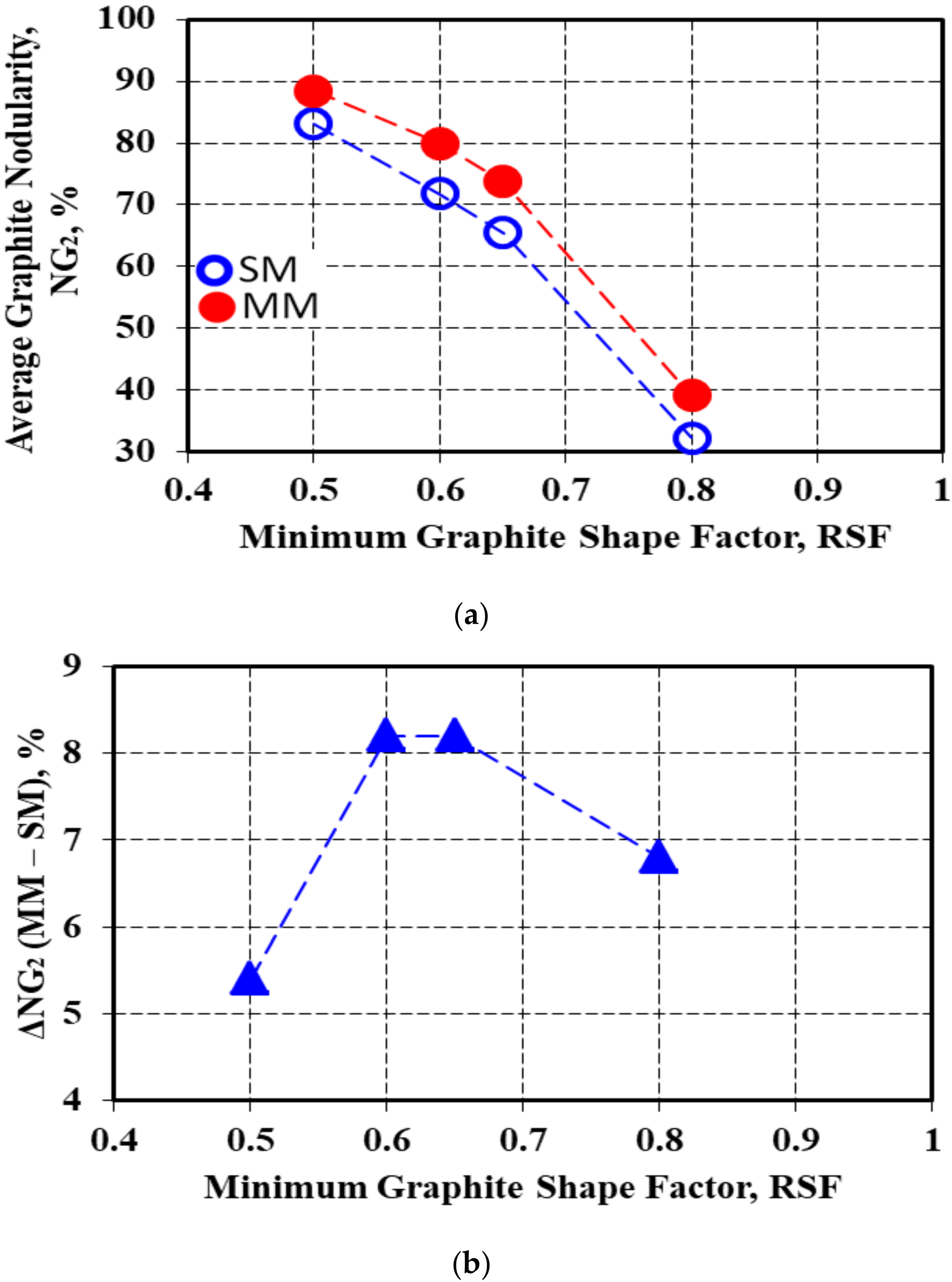
| C | Si | Mn | P | S | Mg | Ce | La | Ca | Al | CE ** |
|---|---|---|---|---|---|---|---|---|---|---|
| 3.33 | 4.55 | 0.22 | 0.04 | 0.01 | 0.035 | 0.0004 | 0.0061 | 0.0038 | 0.0054 | 4.70 |
| Mold Type | Green Sand Mold | Metal Mold | ||||||||
|---|---|---|---|---|---|---|---|---|---|---|
| Casting Section size (mm) | 6 | 9 | 12 | 15 | Average | 6 | 9 | 12 | 15 | Average |
| Convex Perimeter (µm) | 45.590 | 51.416 | 53.849 | 52.359 | 50.804 | 32.573 | 36.632 | 37.121 | 37.927 | 36.063 |
| Real Perimeter (µm) | 47.468 | 53.821 | 55.793 | 55.719 | 53.200 | 35.472 | 35.083 | 38.116 | 39.927 | 37.150 |
| Pr/Pc Ratio | 1.041 | 1.047 | 1.036 | 1.064 | 1.047 | 1.089 | 1.044 | 1.027 | 1.029 | 1.047 |
| ΔP1 (Pr–Pc) (µm) | 1.878 | 2.405 | 1.945 | 3.359 | 2.397 | 2.899 | 1.549 | 0.995 | 1.098 | 1.635 |
| Mold Type | Green Sand Mold | Metal Mold | ||||||||
|---|---|---|---|---|---|---|---|---|---|---|
| Casting Section Size (mm) | 6 | 9 | 12 | 15 | Average | 6 | 9 | 12 | 15 | Average |
| Aspect Ratio | 1.394 | 1.355 | 1.336 | 1.359 | 1.361 | 1.240 | 1.265 | 1.295 | 1.248 | 1.262 |
| Elongation | 1.477 | 1.424 | 1.399 | 1.428 | 1.432 | 1.267 | 1.230 | 1.295 | 1.271 | 1.266 |
| Convexity | 0.911 | 0.916 | 0.922 | 0.911 | 0.915 | 0.933 | 0.934 | 0.935 | 0.937 | 0.935 |
| Roundness Shape Factor | 0.651 | 0.672 | 0.684 | 0.662 | 0.667 | 0.712 | 0.710 | 0.711 | 0.715 | 0.712 |
| Mold | Wall Thickness, mm | Graphite Nodularity, NG2 (RSF), % | |||
|---|---|---|---|---|---|
| RSF, Minimum | |||||
| 0.50 | 0.60 | 0.65 | 0.80 | ||
| Sand Mold | 6 | 80.5 | 69.6 | 61.0 | 25.6 |
| 9 | 82.9 | 70.0 | 65.3 | 32.1 | |
| 12 | 86.3 | 78.4 | 72.6 | 39.9 | |
| 15 | 82.8 | 69.1 | 63.2 | 31.7 | |
| Average | 83.1 | 71.8 | 65.5 | 32.3 | |
| Metal Mold | 6 | 83.0 | 73.4 | 67.3 | 34.1 |
| 9 | 87.1 | 77.8 | 72.6 | 37.8 | |
| 12 | 90.8 | 82.6 | 77.5 | 44.8 | |
| 15 | 93.0 | 84.4 | 77.3 | 39.6 | |
| Average | 88.5 | 80.0 | 73.7 | 39.1 | |
| ΔNG (MM-SM) | 5.4 | 8.2 | 8.2 | 6.8 | |
Publisher’s Note: MDPI stays neutral with regard to jurisdictional claims in published maps and institutional affiliations. |
© 2022 by the authors. Licensee MDPI, Basel, Switzerland. This article is an open access article distributed under the terms and conditions of the Creative Commons Attribution (CC BY) license (https://creativecommons.org/licenses/by/4.0/).
Share and Cite
Anca, D.-E.; Stan, I.; Riposan, I.; Stan, S. Graphite Compactness Degree and Nodularity of High-Si Ductile Iron Produced via Permanent Mold versus Sand Mold Casting. Materials 2022, 15, 2712. https://doi.org/10.3390/ma15082712
Anca D-E, Stan I, Riposan I, Stan S. Graphite Compactness Degree and Nodularity of High-Si Ductile Iron Produced via Permanent Mold versus Sand Mold Casting. Materials. 2022; 15(8):2712. https://doi.org/10.3390/ma15082712
Chicago/Turabian StyleAnca, Denisa-Elena, Iuliana Stan, Iulian Riposan, and Stelian Stan. 2022. "Graphite Compactness Degree and Nodularity of High-Si Ductile Iron Produced via Permanent Mold versus Sand Mold Casting" Materials 15, no. 8: 2712. https://doi.org/10.3390/ma15082712
APA StyleAnca, D.-E., Stan, I., Riposan, I., & Stan, S. (2022). Graphite Compactness Degree and Nodularity of High-Si Ductile Iron Produced via Permanent Mold versus Sand Mold Casting. Materials, 15(8), 2712. https://doi.org/10.3390/ma15082712





